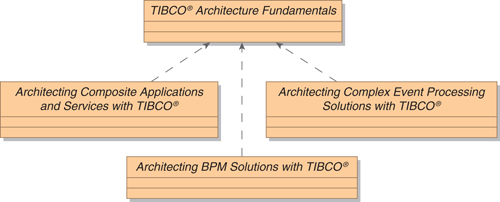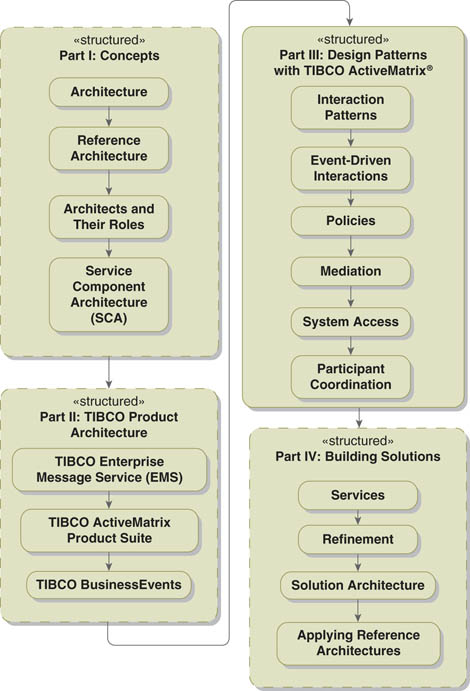Preface
About This Book
The subject matter for this book lies at the intersection of three very broad topics: architecture, solutions, and TIBCO products (Figure P-1). Each of these topics, individually, has been the subject of many volumes. The purpose of this book is to begin to tie these three topics together in a very pragmatic way, providing a foundation for architecting solutions with TIBCO products.
Figure P-1. Subject Matter for TIBCO® Architecture Fundamentals

This book is not intended to provide a comprehensive introduction into any one of the three broader topic areas. Nevertheless, some coverage of these topics is a necessary prerequisite to discussing the specifics of architecting solutions with TIBCO products. Part I provides an introduction to some of the essential concepts of architecture. Part II provides a cursory overview of the TIBCO product stack and explores the architecture of some of the most broadly used products, emphasizing information not readily found in the individual product manuals. Part III takes a bottom-up approach to exploring the most basic and commonly found design patterns used in architecting solutions with TIBCO products. Part IV begins the discussion of services and solutions, emphasizing the application of the design patterns discussed earlier.
Solutions built with TIBCO products tend to be distributed solutions involving multiple systems, multiple data stores, and multiple business processes along with the people participating in those business processes. Thus, the discussion in this book covers the structure and organization of both the participants and the work being performed, with particular emphasis on the mapping of the work onto the participants.
TIBCO® Architecture Fundamentals lays the groundwork for architecting these systems. Part I provides simple working definitions for architecture and reference architecture. It discusses the roles to be played by project and enterprise architects, and the measurable reduction in project duration (up to 25%) that can be achieved by paying appropriate attention to architecture. Part II discusses the organization of the major TIBCO products and describes how solutions progress from design into production. Part III uses design patterns to explore dozens of design choices defining how people and systems can interact and coordinate their work. Part IV examines solution architecture, exploring the notion of services and discussing how reference architectures can be applied when building solutions.
TIBCO Architecture Book Series
As the first book in a series, TIBCO® Architecture Fundamentals only begins the discussion of architecting solutions with TIBCO products (Figure P-2). It lays the foundation for architecting TIBCO-based solutions and serves as a common foundation for the series. Each of the more advanced books explores a different style of solution, all based on TIBCO technology. Each explores the additional TIBCO products relevant to that style of solution. Each defines larger and more specialized architecture patterns relevant to the style, all built on top of the foundational set of design patterns presented in this book.
Figure P-2. Initial TIBCO Architecture Book Series

Intended Audience
TIBCO® Architecture Fundamentals is written for architects and lead engineers designing solutions in which TIBCO products play a significant role. Enterprise architects will also gain some insight as to how they can employ reference architectures to document design patterns. Such reference architectures give voice to their design intent and serve to efficiently give direction to project teams.
To derive maximum benefit from this book, it is useful for the reader to already have some familiarity with the TIBCO product set. The provided overview of the major TIBCO products and their organization is supplementary and is intended to augment the information contained in the product manuals.
Throughout this book the majority of the diagrams employ UML notations, particularly Class, Activity, and Composite Structure diagrams, with occasional use of other UML notations. For the most part, the meaning of these diagrams should be intuitively obvious, and thus a formal understanding of the UML notation is not a requirement for reading this book. On the other hand, the UML notations have a formality and precision that, when properly understood, allow the reader to extract even more information from the diagrams. The Unified Modeling Language Reference Manual, Second Edition,1 is an excellent reference in this regard.
Detailed Learning Objectives
After reading this book, you should be able to:
• Explain the design perspective required for modern IT projects and the concepts of total architecture, architecture, and reference architecture
• Predict the positive impact that architecture can have upon project duration, and explain the roles of project and enterprise architects in achieving this benefit
• Explain the basic SCA concepts and read an SCA diagram
• Describe the core TIBCO products: TIBCO Enterprise Message Service™, TIBCO ActiveMatrix® Service Bus, TIBCO ActiveMatrix® Service Grid, TIBCO ActiveMatrix® BPM, and TIBCO Business-Events™
• Select appropriate design patterns for basic system interactions and identify and select the appropriate TIBCO products to be used
• Outline the capabilities of policies in TIBCO ActiveMatrix Service Bus
• Select appropriate design patterns for mediation, external system interaction, and coordination of activities
• Explain the concept of a service and the criteria for deciding when an investment in a service is warranted
• Explain how a solution architecture should be characterized and how reference architectures can be applied to the building of solutions
Organization of the Book
The book is structured into four parts, as shown in Figure P-3. Part I covers foundational concepts: architecture, reference architecture, solution architecture, the role of architects, and Service-Component Architecture (SCA). The discussions in this portion of the book are relatively abstract (high level) and technology independent.

Part II covers the architecture of the most commonly used TIBCO products: TIBCO Enterprise Message Service (EMS), the TIBCO ActiveMatrix product suite, and TIBCO BusinessEvents. The discussions in this section are technology specific and detailed, getting into the product structure and architecture. Although the discussions are specific to the current version of the products (TIBCO Enterprise Message Service 6.x, TIBCO ActiveMatrix Service Bus and Service Grid 3.x, TIBCO ActiveMatrix BusinessWorks 5.9, TIBCO ActiveMatrix BPM 1.x, and TIBCO BusinessEvents 4.x), most of the discussions will remain valid as these products evolve. Most product changes will result in augmentations rather than alterations.
Part III examines foundational design patterns: interactions between pairs of components, event-driven interactions, policies, mediation, external system access, and the coordination of activities. The discussions in this section are a mixture of technology-neutral design patterns and product-specific implementation choices for these patterns. Some discussions, particularly those surrounding policies, get quite detailed.
Part IV looks at building solutions, examining the concept of services, building solutions through the process of refinement, and applying reference architectures (design patterns). The discussions in this section are, once again, abstract (high level) and technology independent.
The book is intended to be read linearly, but there is some flexibility in this. Parts I and II can be read independently, but the discussions in Part III require an understanding of both prior parts. Part IV can be read after Part I, but the reader will find its discussion more compelling if Parts II and III have been read first.
